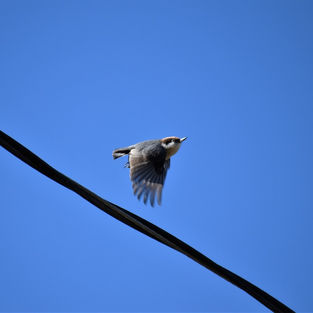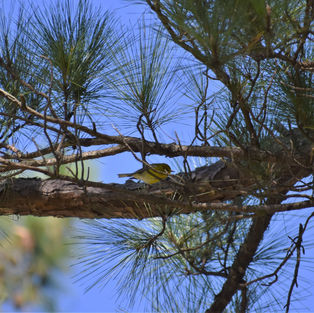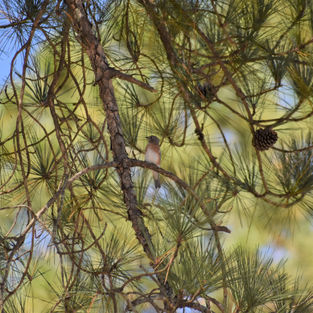Birds Of North Carolina!
These are a few of the popular and well sighted bird species in North Carolina. This section will discuss the physical attributes as far as color and behavior.

American Crow
-
Get together in the winter to sleep communally in roosts
-
All black, including black beak and legs
-
No difference in male or female
Mourning Dove
-
There are about 475 million individual mourning doves
-
Light brown coloration
-
No difference between male or female
Downy Woodpecker
-
Smallest woodpecker species in North America
-
Black and white coloration similar to Hairy Woodpecker with smaller beak than Hairy
-
Male has red patch on the back of the head but female does not



Red Shouldered Hawk
-
Used to be one of the most common raptors in North America
-
Appear to have brown head, dark brown back and underneath while flying, they appear to have a light-red underside
-
Males and females similar in appearance (females are slightly larger)
Red-Tailed Hawk
Most commonly used bird for falconry in the U.S.
Can appear to be light-brown or dark-brown bodies with a warm red tail
Male and females are similar in appearance (females are slightly larger)
Tufted Titmouse
-
Their alarm call sounds like it fades in the distance, making them seem like they are moving farther away while in fact they haven't moved much at all
-
Silvery grey on top and white on bottom with a black patch right behind the beak. They also have a crest on the top of their head
-
Male and female similar in appearance
Canada Goose
-
Large groups fly in a V-shaped formation, which signifies the change of spring to autumn
-
Large body with black head and neck, cheeks that are white under the chin, and a brown body
-
No difference in male or female
-
Found throughout the United States
White-breasted Nuthatch
-
Only species able to walk straight up and down a tree
-
All of the nuthatches build their nests in cavities
-
Only four species of nuthatches in North America
-
Males have a dark black head where as females have a lighter gray
American Redstart
-
They are referred to as the "Butterfly of the bird world"
-
Males sometimes have two mates at the same time
-
Males are black with orange patches on his side, wings, and tail and females are gray with yellow patches on their sides, wings, and tail
Pileated woodpecker
-
Some pileated woodpeckers stay in their territory year round
-
North America's biggest woodpecker
-
Males and females look similar but the males have a red stripe on their cheek and the females have a black stripe.
Prothonotary Warbler
-
This species forages above standing or slow moving water
-
It flies with an undulating pattern
-
The male Prothonotary warbler color is described as bright yellow with an olive back and grayish wings
-
The female Pronthonotary warbler is the same as the male but more pale in comparison
Fish Crow
-
Steal aquatic food sources from other birds species
-
Similar to the American Crow, but smaller overall and has a nasal voice
-
Males have bigger feet, larger legs, and longer females than females
-
Found in wetlands habitats in South Eastern U.S.
Great Egret
-
Feathers have been historically used to decorate women's hats
-
Body is completely white, with long black legs, and non-webbed feet
-
No differences between male and females
-
Found in the mid and lower regions on North America
Blue Jay
-
Has a heavy bill which is ;used to break open nuts
-
Mainly Blue, with white chest and a blue crest
-
Males are slightly larger than females
-
Lives predominantly in Eastern half of America
Dark-eyed Junco
-
Protected under the Migratory Bird Treaty Act
-
Smell grey American Sparrow, white outer tail feathers
-
Males have darker markings
-
Habitats all over the US and Canada
Hairy Woodpecker
-
75% of diet consists of insects
-
Larger bill than Downy Woodpecker, Longer and distinctive black mark on shoulder with white outer tail
-
Found in high elevation mountains and sea level mature woodlands with medium to large size trees
Yellow Warbler
-
Yellow warblers can be spotted near the tops of tall shrubs and small trees
-
The male Yellow Warbler colors are bright yellow all over with reddish streaks on their underparts
-
The female Yellow Warbler is similar in comparison to the male Yellow Warbler
Carolina Chickadee
-
Able to lower body temperature to create a intentional state of hypothermia, which is called torpor
-
Black cap & bib separated by white cheeks
-
Found in southeastern United States throughout all seasons
-
Male has larger black bib than females
Brown headed nuthatch
-
The Brown headed nuthatch's habitat is located in Southeastern pine forest that include lobolly, shortleaf, longleaf, and slash pine habitats
-
It is most common in open mature pine forest
-
The Brown headed nuthatch's beak is characterized as a chiseled beak
Red Bellied Woodpecker
-
Able to stick out tongue almost 2 inches past its beak
-
Male has a red crown and nape that extends all the way to the forehead to back of neck, while females lacks the red crown
-
Found throughout eastern US year around
-
Medium-sized Mostly black with white wing patches and red crown/nape
Chipping Sparrow
-
Found throughout North America seasonally
-
Small with notched tail and brownish orange russet cap during breeding season, gray underparts and rump
-
Females are bigger and have less coloration
-
Females develop bare patch on abdomen that fills with fluid to allow transfer for heat to eggs











.jpg)











